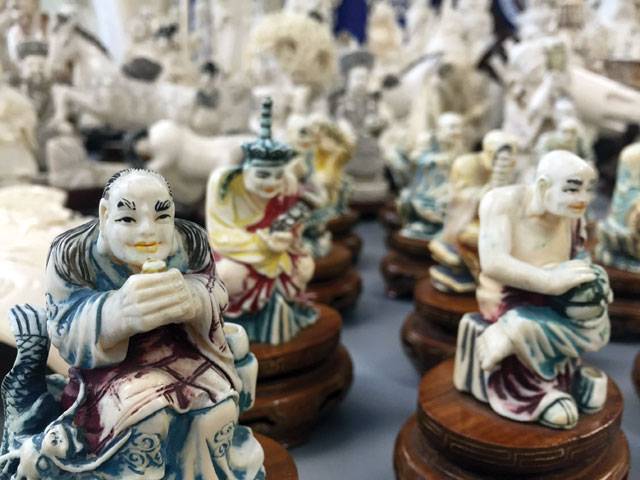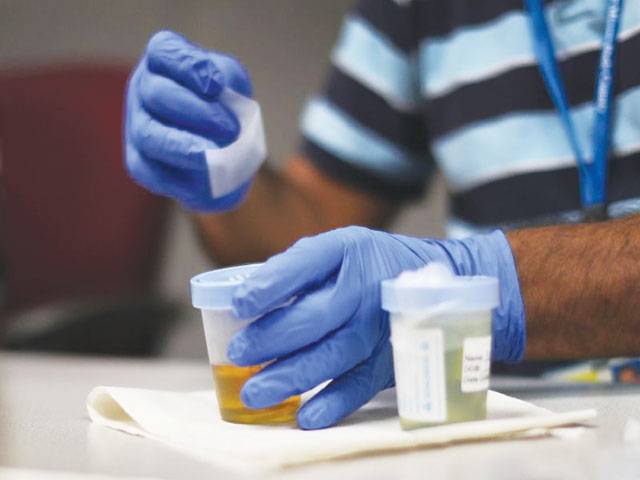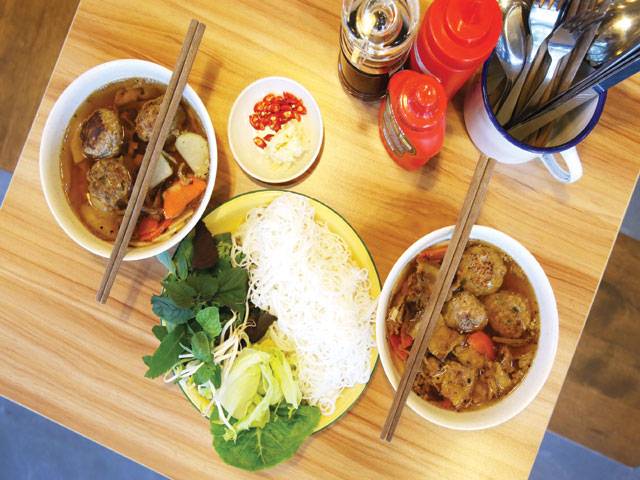NY seizes $4.5m worth of elephant ivory items
NEW YORK (AFP): The New York authorities seized $4.5 million worth of illegal elephant ivory items in what they described as the biggest bust in the state’s history, officials have said. Ivory items put on display for reporters included scores of statuettes, a carved column, two pairs of tusks and a chess set. Two pairs of tusks - an adult elephant’s and another from a young adult - were valued at $200,000 and $150,000, respectively. The ivory came from at least 12 slain animals, officials said. “We are going to dry up... a market that only fuels the slaughter of elephants,” Manhattan District Attorney Cy Vance said. “It is inexcusable, it is immoral.”
New York City is a hub of illegal elephant ivory trade, ahead of California and Hawaii, said Basil Seggos, head of the state’s Department of Environmental Conservation. His office participated in the probe.
“This type of behavior will no longer be tolerated,” he said.
New York was one of the first states in 2014 to adopt strict laws banning ivory sales to protect elephants, Vance said.
Undercover police posing as buyers seized the latest items at a midtown Manhattan art and antiquities store.
Although officials said they were not certain where the items came from, they did say most ivory craftsmen are found in China.
It is illegal to sell elephant ivory without a special license. But New York’s rules were tightened so much in 2014 that they effectively banned ivory sales except under limited circumstances.
Although the store had a license, it expired two years ago and could not be renewed because of the new restrictions.
The store owners were indicted on charges of illegal commercialization of wildlife. They face hefty fines and up to three years in prison.
The United States and China, among the world’s biggest ivory consumers, have agreed to enact near-total bans on their domestic markets.
The Convention on International Trade in Endangered Species (CITES) banned the international commercial trade in African elephant ivory in 1989. But illegal poaching of endangered elephants for their tusks persists at dangerous levels.
Savanna elephants have declined at a rate of 27,000 - or eight percent - per year, with a total of 144,000 lost in less than a decade.
Two experimental Zika vaccines show promise in monkey studies
WASHINGTON (AFP): A pair of experimental vaccines being developed by the US National Institutes of Health protected monkeys against Zika virus infection after two doses, researchers said Thursday. One of the vaccines, known as VRC5288, has already begun early trials in humans to test safety and efficacy, according to a study published in Science. A phase 2 trial in Zika-endemic countries could begin next year, officials said. The second vaccine (VRC5283) is awaiting a Phase 1 clinical trial start date. The research involved vaccinating rhesus macaques using “the two different experimental Zika DNA vaccines in different doses,” said the NIH in a statement.
Two doses were “highly effective” at protecting macaques exposed to an infectious dose of Zika virus.
Experts say it will be years before a vaccine is developed to prevent infection from Zika, which is particularly dangerous to pregnant women because it can cause brain defects in the fetus.
Digitally unwrapped scroll reveals ancient Hebrew scripture
MIAMI (AFP): An extremely fragile, ancient Hebrew scroll has been digitally unwrapped for the first time, revealing the earliest copy of Old Testament Bible scripture since the Dead Sea Scrolls, researchers have said. Known as the En-Gedi scroll, it contains text from the Book of Leviticus, and dates at least to the third or fourth century, possibly earlier, according to the report in the journal Science Advances. The deciphering of its contents is described in the journal as a “significant discovery in biblical archeology.” The scroll is not the oldest ever found - that honor belongs to the biblical Dead Sea Scrolls which range from the third century BC to the second century of the common era (AD).
Radiocarbon analysis has shown that the En-Gedi scroll dates to the third or fourth century AD.
Some experts think it is older than that. An analysis of the handwriting style and the way the letters are drawn suggests it could date to the second half of the first century or the beginning of the second century AD. Its contents were long thought to be lost forever, because it was burned in a fire in the 6th century and was impossible to touch without dissolving into chunks of ash.
The scroll was found by archeologists in 1970 at En-Gedi, the site of a large, ancient Jewish community dating from the late 8th century BC.
Its fragments were preserved by the Israel Antiquities Authority for decades.
“Each fragment’s main structure, completely burned and crushed, had turned into chunks of charcoal that continued to disintegrate every time they were touched,” said the study.
So researchers used advanced digital scanning tools to “virtually unwrap” the scroll and see its contents, without ever touching it.
A micro-computed tomography (micro-CT) scan was able to pick up traces of metal in the ink.
“We were amazed at the quality of the images,” said Michael Segal, head of the School of Philosophy and Religions at Hebrew University of Jerusalem. “Much of the text is as readable, or close to as readable as actual unharmed Dead Sea Scrolls or high resolution photographs of them.”
Before the scroll was digitally unveiled, experts believed the artifact may have been an entire Torah scroll. But a look at the images showed it was the Book of Leviticus, from the third book of the Book of Moses.
This makes it the earliest Pentateuchal book - relating to the first five books of the Jewish or Christian scriptures - ever found in a synagogue.
Some earlier evidence of Leviticus texts do exist in the Dead Sea Scrolls, which were unearthed from caves or in excavations, explained Segal.
The En-Gedi scroll shows 18 lines of text in each column, which were originally 35 lines long.
Like other ancient Hebrew scrolls, it contains only consonants and no vowels.
Symbols for vowels were not introduced in Hebrew until the 9th century.
“We were immediately struck by the fact that in these passages, the En-Gedi Leviticus scroll is identical in all of its details both regarding its letter and section division to what we call the Masoretic text, the authoritative Jewish text until today,” said Segal.
Its uniformity with the medieval texts stunned researchers, who said it was 100 percent the same, both in its consonants and in its paragraph divisions.
“We have never found something as striking as this,” said Emanuel Tov, professor emeritus in the department of Bible at Hebrew University of Jerusalem.
“This is quite amazing for us that in 2,000 years this text has not changed.”
Researchers hope the techniques developed to read it will be used on other scrolls, including some from the Dead Sea Scroll collection, which have remained undecipherable until now, and others from disasters such as the eruption of Mount Vesuvius in the 1st century.
The technology, called “Volume Cartography” and developed with funding from the US National Science Foundation, will become freely available next year as open source software, researchers said.
It could also be useful to intelligence agencies or investigators.
“Damage and decay is the natural order of things, but you can see that sometimes you can absolutely pull a text back from the brink of loss,” said co-author Brent Seales, professor and chairman in the department of computer science at the University of Kentucky.
“The En-Gedi scroll is proof positive we can potentially recover whole texts from damaged material, not just a few letters or a speculative word,” said Seales.
Obama’s Vietnam noodle visit sparks feeding frenzy
HANOI (AFP): Four months after US President Barack Obama plonked down on a plastic stool at Bun Cha Huong Lien for a bowl of Hanoi’s signature pork noodles, the restaurant is cashing in on customers eager to taste what all the fuss is about. Previously a mainstay among a mostly local customer base, hungry foreigners are now coming in droves to the restaurant dubbed “Obama bun cha” for the Hanoi lunch staple: grilled pork patty and bacon in a sweet broth with rice noodles. “People come here because they are curious about why Obama chose my restaurant,” said owner Nguyen Thi Lien, who has been running the eatery for 23 years.
Eager to tap the star power of her recent VIP diner, Lien has introduced a $4 “Combo Obama” lunch special of noodles, a side of deep fried spring rolls and a Hanoi beer - but swears she has kept her prices the same.
“So many have come and we cannot serve them all,” she said at the two-storey restaurant, which is now plastered with photos of Obama and his dinner guest, globetrotting US chef Anthony Bourdain.
The pair stopped by during Obama’s May trip to Vietnam - the third by a sitting president since the end of the Vietnam War in 1975 - to film a scene for Bourdain’s CNN show “Parts Unknown” which airs Sunday.
In a teaser for the episode, Bourdain lauded the US leader for his chopstick skills as he expertly scooped up a mouth of noodles during an evening off from his diplomatic duties.
Obama seemed impressed with the local fare. “This is killer, this is outstanding,” he said.
The pork pit stop has seen the number of customers double, according to Lien, and the restaurant appears set to become a fixture on Hanoi’s tourist trail.
“I saw that Obama had been here, saw that Anthony Bourdain had been here, and I generally follow their advice, figured they’d have good taste, came here and found it to be true,” American tourist Andrew Lala told AFP.
Grab expands self-driving car trial in Singapore
SINGAPORE (AFP): Southeast Asia’s leading ride-hailing firm Grab on Friday teamed up with a US-based software developer to run a limited public trial of a self-driving car service in Singapore. Applications for free rides on the “robo-cars” opened on Friday, with the service expected to kick off next week, Grab Singapore head Lim Kell Jay told journalists. The revolutionary technology will be used to ferry passengers as well as a safety driver and an engineer around One North, a research campus with limited traffic. “If a trip requires travel on roads outside of One North, the safety driver will take control of the vehicle for that portion of the trip,” a joint statement by Grab and software company nuTonomy said.
The partnership follows the September 15 launch of a groundbreaking driverless car service in the US city of Pittsburgh by Uber, the world’s leading car-hailing company.
The trial will run for the next two months, and may be extended for as long as it continues to yield useful feedback and data that can feed into the roll-out of driverless taxis across Singapore in 2018.
The announcement came three days after Singapore-based Grab said it had raised $750 million in funding from investors, taking its total capital to more than $1.0 billion, as it looks to expand in the lucrative Southeast Asian market and bolster its lead over Uber.
But Uber’s launch of a driverless car service last week catapulted it ahead of Detroit auto giants and Silicon Valley rivals with technology that could revolutionise transportation.
In an ambitious experiment, a fleet of cars laden with lasers, cameras and other sensors - but with no hands on the wheel - were deployed on Pittsburgh’s challenging roads, steering themselves to pick up passengers.
In addition to Uber and Grab, Google’s parent company Alphabet is also working on getting self-driving vehicles to market.
Grab’s Singapore trials are backed by the wealthy city-state’s government.
But Karl Iagnemma, chief executive and co-founder of nuTonomy, brushed off suggestions that the launch was timed to take the shine off Uber’s Pittsburgh success.
“My strong belief of what we’re going to see is the emergence of multiple regional winners,” Iagnemma said.
Competition between Uber and local startups has grown fierce in Southeast Asia, home to more than 600 million people and a rising middle class.
Grab operates in Singapore, Indonesia, the Philippines, Malaysia, Thailand and Vietnam.










